

MIT researchers to 3D print a pavilion by imitating silkworms. Researchers at MIT plan to 3D print a pavilion by imitating the way a silkworm builds its cocoon.

The research team, headed by architect and Mediated Matter Group founder Neri Oxman, attached tiny magnets to the heads of silkworms to discover how they “print” their pupal casings around themselves. “We've managed to motion-track the silkworm’s movement as it is building its cocoon,” said Oxman. Amsterdam architects plan 3D-printed canal house. News: Dutch studio DUS Architects has joined the race to build the first 3D-printed house with plans to print a full-size canal house in Amsterdam.
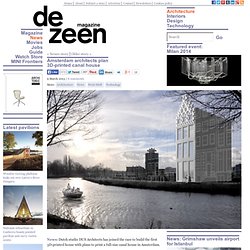
DUS Architects will print components for the house on-site using a purpose-built printer called the KamerMaker (above and below) and plan to start work in the next six months. "This year we want to print the entire facade and the first room bit by bit," architect Hedwig Heinsman told Dezeen. "Then in the following months and years we will print other rooms. " The KamerMaker, which is Dutch for "room maker", is 3.5 metres high and sits inside a shipping container. ProtoHouse by Softkill Design. London architecture team Softkill Design has designed a conceptual house that would be 3D printed in sections in a factory and fitted together on site (+ interview transcript).
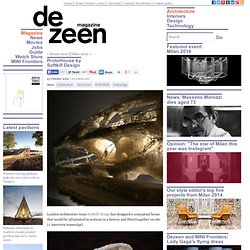
Above image is by Julia Kubisty Designed to cantilever out from a hillside, the structure of the house was generated using an algorithm that imitates bone growth to deposit material where it is needed along lines of stress, resulting in a fibrous web rather than a solid envelope. The structure is porous, allowing rain to permeate, with waterproofing on the inside rather than the outside. The house would be printed in 31 sections using the largest 3D printer currently available, then transported by truck to the site and fitted together. Aaron Silver of Softkill Design told Dezeen that 3D printing could result in cheaper buildings that use less materials. Silver added that cladding materials and roofing could be printed as flexible fabrics and draped over buildings. Radiolaria pavilion by Shiro Studio. Andrea Morgante, founder of Shiro Studio, has collaborated with D-Shape to produce the Radiolaria pavilion, a complex, free-form structure produced using the world's largest 3D printer.

Measuring 3 x 3 x 3 metres, the structure is a scale model of a final 10-metre tall pavilion to be built in Pontedera, Italy, in 2010. D-Shape, the world's first large-scale stereolithic printer, was developed by Italian engineer Enrico Dini in 2008 to offer architects the design freedom that rapid prototyping allows. The structure is made of an artificial sandstone material and does not feature any internal reinforcement.
Held together by an inorganic binder, the resultant material has excellent strength properties - with some performance characteristics superior to portland cement - and will not damage the environment. Stone Spray Robot by Anna Kulik, Inder Shergill and Petr Novikov. Students from Barcelona's Institute for Advanced Architecture of Catalonia have built a robotic 3D printer that creates architectural structures from sand or soil (+ movie).

Above: visualisation is by the designers Anna Kulik, Inder Shergill and Petr Novikov suggest that the technology could be used to build temporary canopies or bridges, as pictured. The Stone Spray robot sprays the grains of sand or soil out of one nozzle and glue out of another to make a mixture that solidifies as it hits a surface. Unlike other 3D printers, the robot's arm moves multi-directionally and can also print onto vertical surfaces. Novikov will present the project at the 3D Printing Event in Eindhoven on 23 October 2012. You can also enter our competition to win a weekend pass to the 3D Print Show in London, which takes place between 19 and 21 October 2012. See all our stories about 3D printing »See all our stories about robots »
Prototype unveiled for world’s first 3D-printed room. News: architects Michael Hansmeyer and Benjamin Dillenburger have revealed a prototype for the world’s first 3D-printed room.
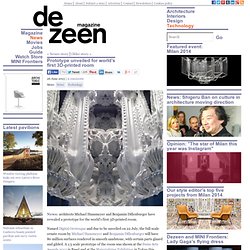
Named Digital Grotesque and due to be unveiled on 22 July, the full-scale ornate room by Michael Hansmeyer and Benjamin Dillenburger will have 80 million surfaces rendered in smooth sandstone, with certain parts glazed and gilded. Gilles Retsin of Softkill Design on 3D printed houses. Interview: earlier today, London studio Softkill Design unveiled plans for a 3D printed house.
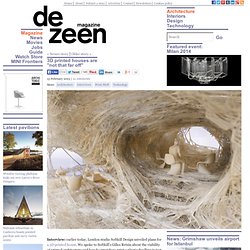
We spoke to Softkill's Gilles Retsin about the viability of printed architecture and how he intends to print a plastic dwelling in just three weeks. "When we started this research, it was a kind of science fiction," he says. "It's not actually that far off any more. " Amy Frearson: Tell us how the project came about. Gilles Retsin: The prototype, ProtoHouse 1.0, started as academic research at the AA Design Research Lab. Building Bytes 3D printed bricks by Brian Peters at Dutch Design Week. Dutch Design Week: architect Brian Peters has adapted a desktop 3D printer to produce ceramic bricks for building architectural structures (+ movie).
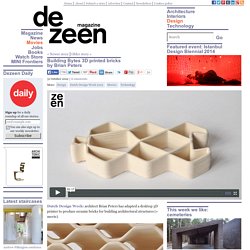
"I've been working with desktop 3D printers for the past couple of years and wanted to transform the machine to build something on a larger, more architectural scale," Peters told Dezeen. A 6-week residency at the European Ceramic Work Centre in the south of the Netherlands provided him with the opportunity to experiment with printing ceramics from a liquid earthenware recipe normally used in mould-making. The only modification required for the printer was the addition of a custom extrusion head. The resulting Building Bytes project predicts that 3D printers will become portable, inexpensive brick factories for large-scale construction.
"You could have several of these machines working simultaneously on site using pre-made or locally manufactured material," he says.